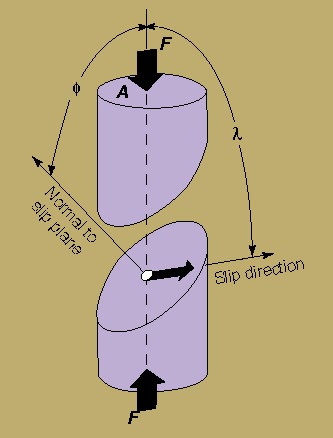FLOW IN POLYCRYSTALLINE ICE
Part 2 - Background information
By Chris Wilson and Brett Marmo
2.10 Critical resolved shear stress
Crystalline slip results from the action
of a shear stress on the slip plane. Within the range of stresses in natural
situations, the component of stress normal to the slip plane does not
influence slip. Thus the slip process must be considered in terms of the
shear stress resolved on the slip plane in the slip direction. Consider
a single crystal of cross-sectional area A under a tensile force
F (Fig. 2.10.1). Let ![]() be the angle between the slip plane normal and the compression axis, and
be the angle between the slip plane normal and the compression axis, and
![]() the angle between the slip direction and the tensile axis. The component
of the applied force, acting in the slip direction is
the angle between the slip direction and the tensile axis. The component
of the applied force, acting in the slip direction is ![]() ,
and the area of the slip plane is
,
and the area of the slip plane is ![]() .
The shear stress resolved in the slip direction is then
.
The shear stress resolved in the slip direction is then
![]()
where ![]() is the applied tensile stress F/A.
is the applied tensile stress F/A.
Figure 2.10.1:Two separated portions of a
crystal showing a model for calculating the resolved shear stress in a
single-crystal specimen. F is the applied force, A is the
cross-sectional area of the specimen, ![]() is the angle between the normal-to-the-slip plane and the compression
axis, and
is the angle between the normal-to-the-slip plane and the compression
axis, and ![]() is
the angle between the slip direction and the compression axis.
is
the angle between the slip direction and the compression axis.
The stress required to initiate slip in a
pure and perfect single crystal, the critical resolved shear stress (CRSS)
is a constant for a material at a given temperature. This rule, known
as Schmid's Law, has been experimentally proven for a large number of
single crystals. The critical stress required to cause yielding is a function
of ![]() or the Schmid factor. The
slip plane with the greatest resolved shear stress acting upon it will
predominate in the slip process.
or the Schmid factor. The
slip plane with the greatest resolved shear stress acting upon it will
predominate in the slip process.
